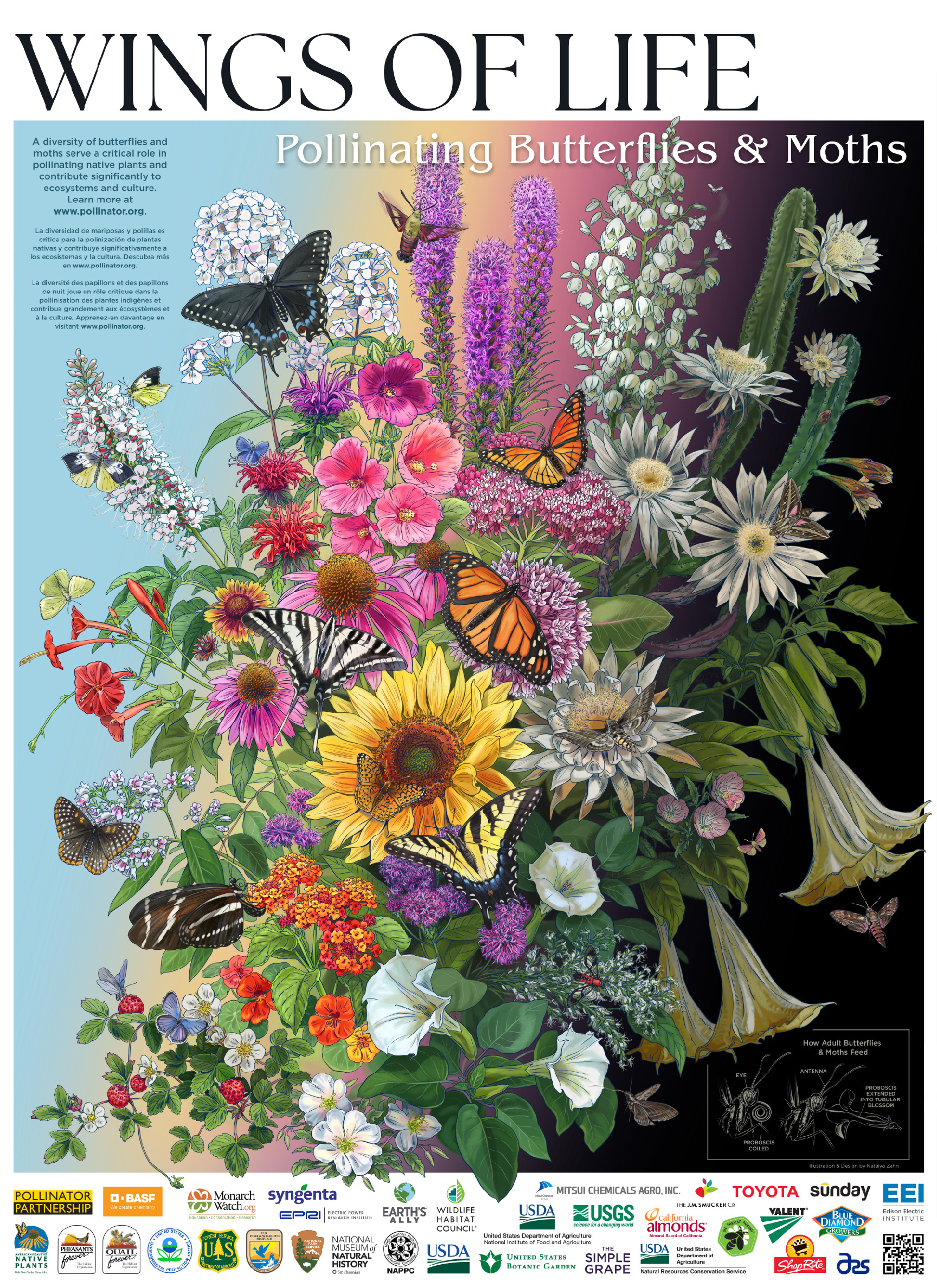Wings of Life: Pollinating Butterflies and Moths
The 2022 Wings of Life Pollinator Poster features butterflies and moths and the essential role they play in pollination, culture, and ecosystem services throughout North America. Butterflies and moths are found in almost every terrestrial ecosystem from deserts to tropical rainforests, and thousands of flowering plants have evolved to rely specifically on their pollination services. Beautiful artwork by Natalya Zahn. Order yours today!
Poster is 24'W x 33'H
Click here for a virtual tour of the poster!
(Be patient. This sometimes takes a while to load.)
Order Poster
Shipping to Canada? Use the payment button below.
About the Artist

Natalya Zahn is a Vermont-based illustrator and designer deeply inspired by science and nature. Since graduating from the Rhode Island School of Design with a degree in Illustration, Natalya has spent the last two decades building an independent practice focused on artfully representing plants, animals, and natural subjects for a wide range of industries. Her unique illustration style blends accuracy with playful artistic expression, and her technical versatility has allowed her to successfully navigate numerous specialty fields, from tightly-rendered scientific and medical illustration, to unique interpretive exhibit design and editorial publishing, to narrative story-boarding, branded product packaging, and creative consulting. Practiced in an ever-evolving, layered mix of traditional and digital media, Natalya’s passion for biology, zoology, botany, anatomy and natural history has led to collaborations with clients including National Geographic, the MIT Media Lab, the Harvard Museum of Comparative Zoology, the Cornell Lab of Ornithology, the San Diego Zoo, and Longwood Botanic Gardens. Natalya’s portfolio can be viewed at: www.natalya.com.
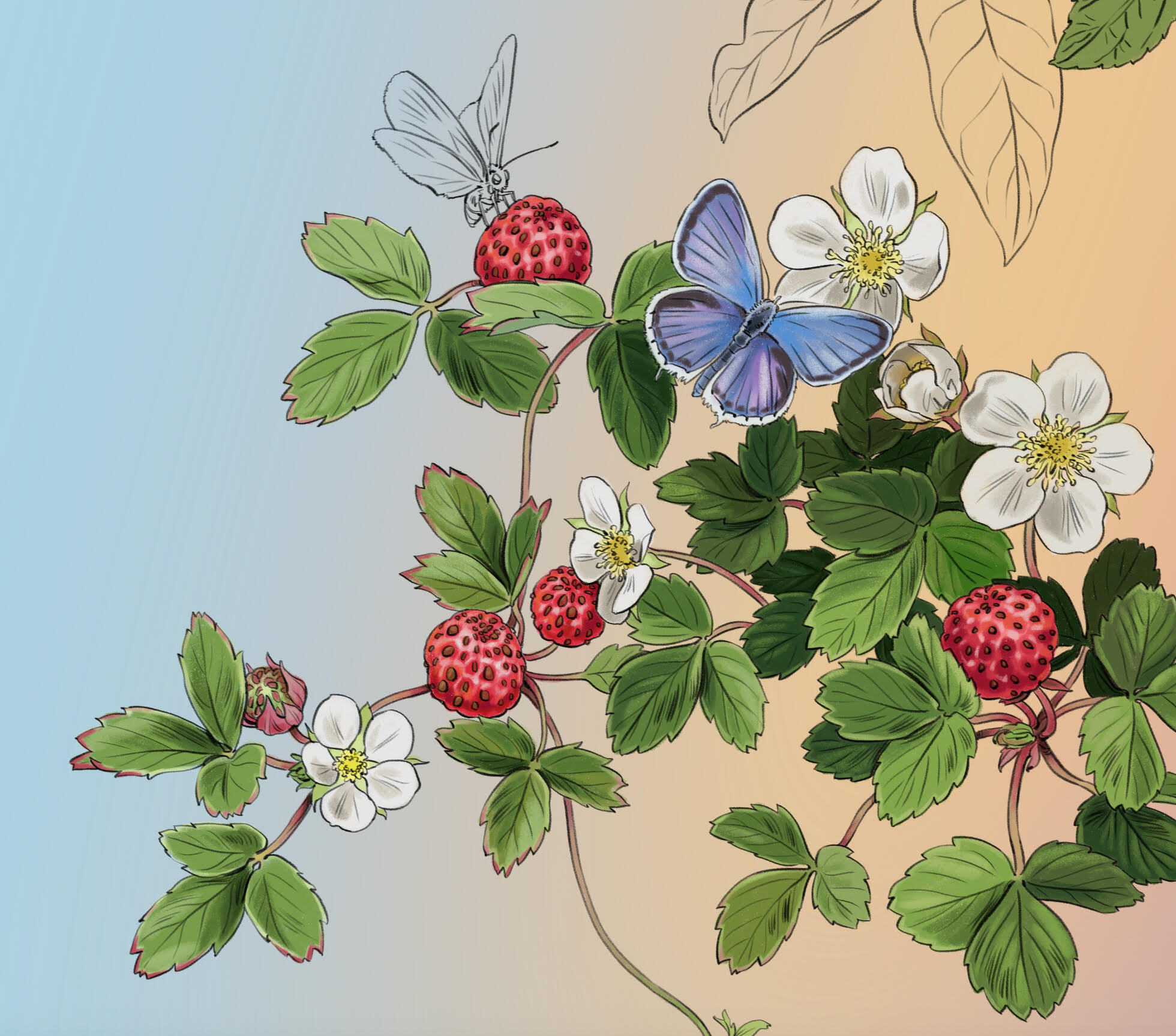
POSTER PROCESS
"The theme for this year’s poster - “Wings of Life” - was instantly inspiring for me; a celebration of fanciful, jewel-winged pollinators, and a showy rainbow of the blossoms they feed on quickly came to mind in the form of a luscious bouquet teeming with beautiful butterflies and moths. I imagined a composition with energy and aesthetic somewhere between a Baroque still life and an elegant fashion magazine spread... based on that concept, I began researching native North American flower and Lepidoptera relationships to assemble my botanical arrangement. It was important to me to include plants and insects that represented as wide a spectrum of colors, sizes, and patterns as possible - that range was additionally divided into diurnal and nocturnal blooms and feeding insects, giving the poster a dynamic, horizontal transition from light to dark.
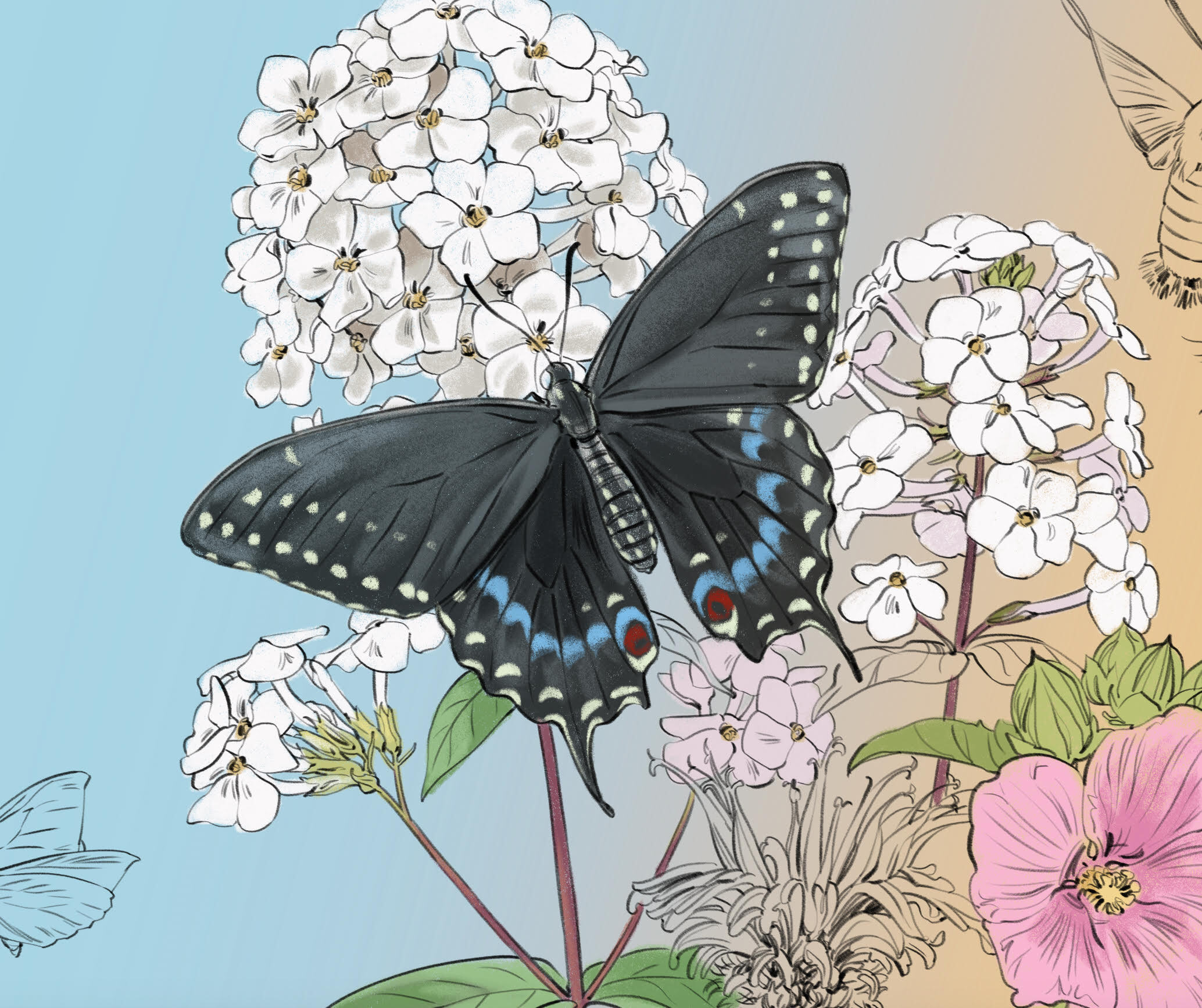
Once the concept sketch was accepted, I received plentiful input from the Pollinator Partnership's expert team of scientific advisors. This research and “proofing” phase of the process is always highly enjoyable for me as I end up learning a tremendous amount about my subjects. It was also one of the most challenging phases of this project since every species edit or substitution had the potential to cause a ripple effect of rearrangement in order to achieve visual harmony within the larger grouping. Like working on a jigsaw puzzle, I slowly configured just the right positioning for each blossom and every butterfly and moth, and a detailed drawing was eventually finished for one last review.
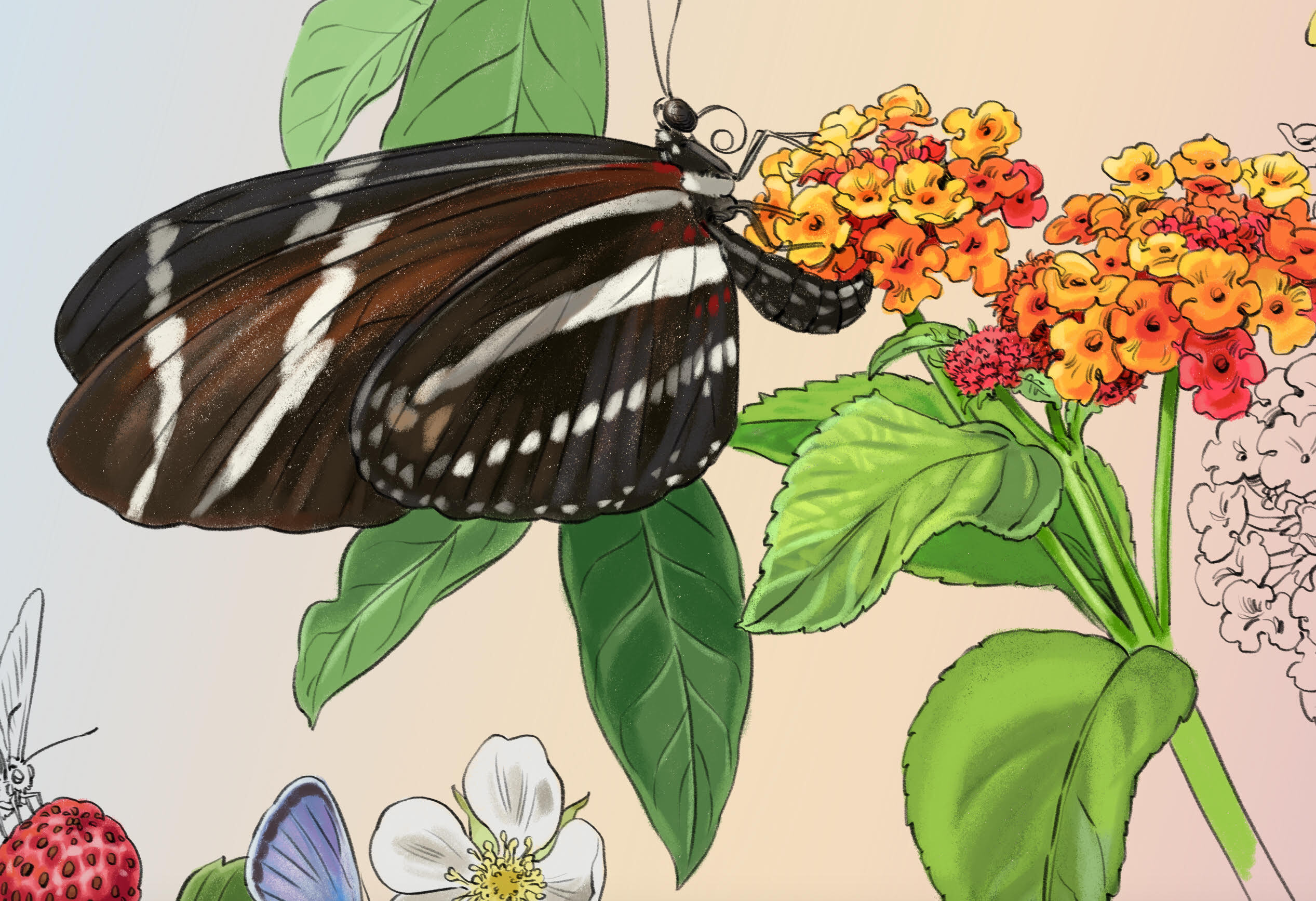
After sign-off of the completed drawing, I commenced to coloring. Every step of this process was done digitally, using Adobe Photoshop and a Wacom Cintiq drawing display. Plants, insects, backgrounds and type each got their own layers, and digital brushes that mimic traditional mediums like graphite and pastel were selected, for a slightly textured and more “natural” feel. Each fine detail was meticulously rendered and cross-referenced with photos for accuracy until the final art was complete." - Natalya Zahn
Featured Butterflies
Photo by Aaron Carlson, courtesy of Wikimedia Commons CC BY-SA 2.0
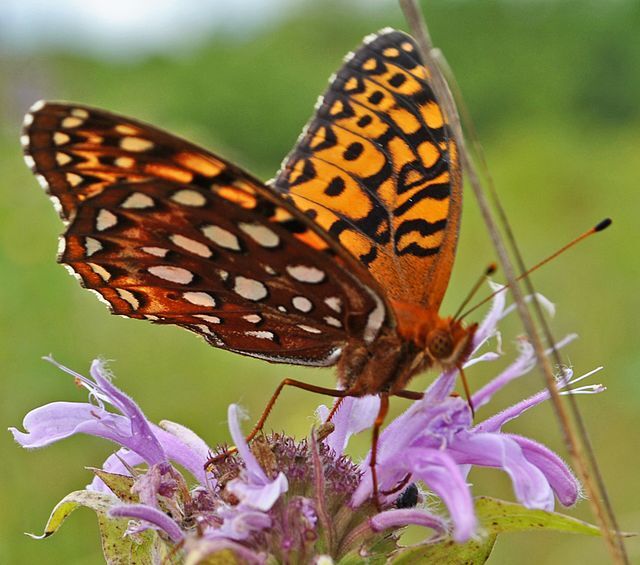
Aphrodite Fritillary Butterfly (Speyeria aphrodite)
The Aphrodite Fritillary (Speyeria aphrodite) is a medium-sized butterfly named for the Greek goddess of love and beauty. You can spot these beauties by the reddish, orange-brown wings and can find them all across North America from southern Nova Scotia to the Great Plains and west to the Rocky Mountains down into east-central Arizona and northern Georgia. They are abundant and not considered endangered. Females usually lay eggs near violets which serve as food for caterpillars. Once they grow into adulthood, the Aphrodite Fritillary will nectar on violets (Viola spp.), milkweeds (Asclepias spp.), and the Common Sunflower (Helianthus annuus) [pictured]. Sunflowers are part of the Asteraceae family, though they used to be categorized under Compositae because they are actually a composite of multiple flowers. Sunflowers flower between July and October and their multiple floret structures attract many pollinators.
https://www.butterflyidentification.com/aphrodite-fritillary.htm
https://www.butterfliesandmoths.org/species/Speyeria-aphrodite
https://animaldiversity.org/accounts/Speyeria_aphrodite/#conservation_status
https://www.fs.usda.gov/wildfl...
Photo by Judy Gallagher, Courtesy of Flickr CC BY 2.0
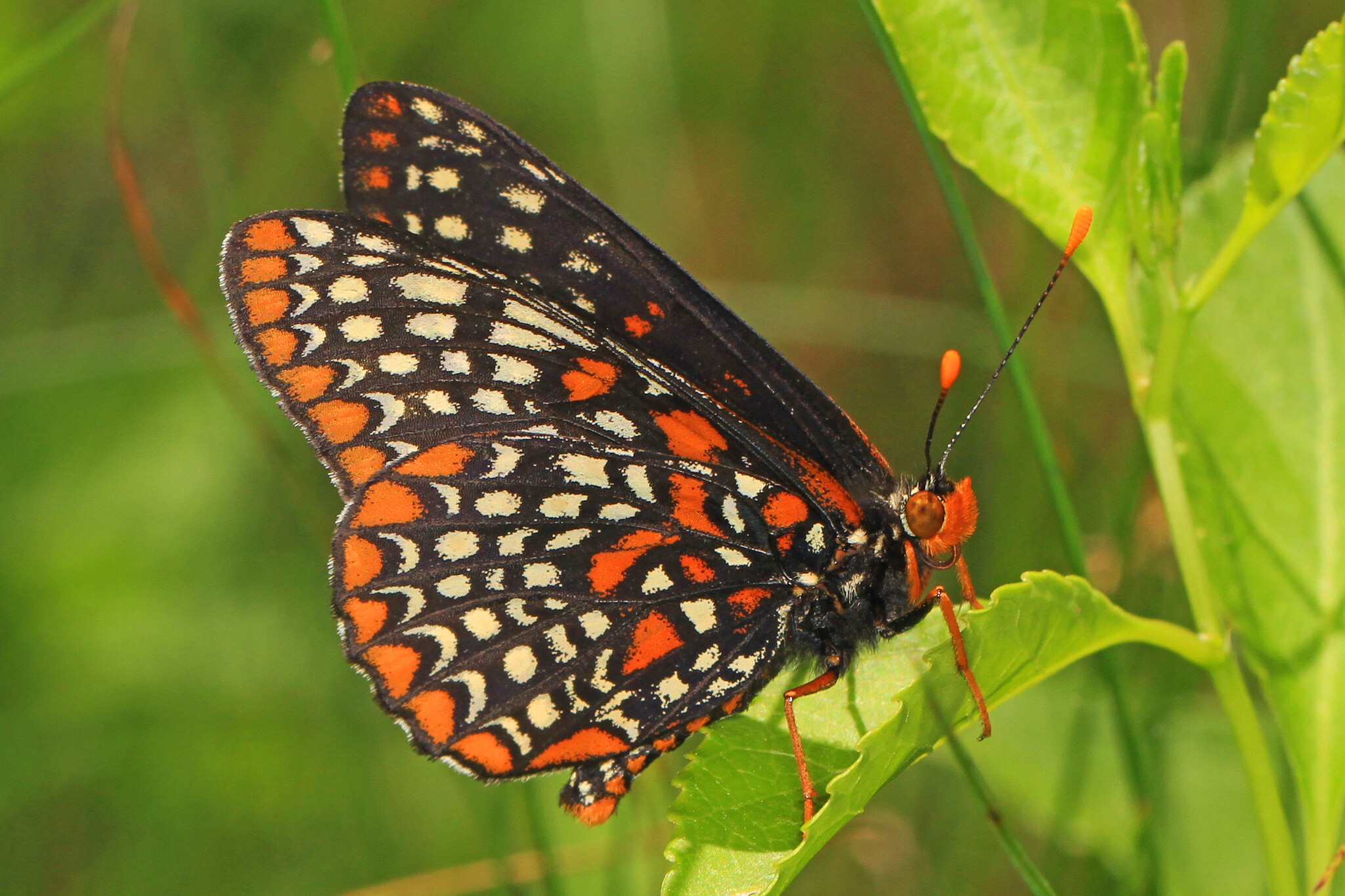
Baltimore Checkerspot Butterfly (Euphydryas phaeton)
The Baltimore Checkerspot gets its name from the orange and black colors of the heraldic shield of George Calvert who was the first Lord Baltimore. It is also the state insect of Maryland. The range of these butterflies is very local and some populations are thought to be declining. The most common host plant for Checkerspots is the White Turtlehead (Chelone glabra) which contains chemicals called iridoid glycosides, making them taste bad to birds. In adulthood, the Checkerspots nectar on Common Milkweed (Asclepias syriaca) and Spreading Dogbane (Apocynum androsaemifolium) [pictured], another plant that is toxic to humans, dogs, livestock, and some other mammals but not for the Checkerspot. In fact, milkweeds and dogbanes are closely related!
https://wildadirondacks.org/adirondack-butterflies-baltimore-checkerspot-euphydryas-phaeton.html
https://dnr.maryland.gov/wildlife/Documents/2013_Plan_ConservationBaltimoreCheckerspot.pdf
https://www.butterfliesandmoths.org/species/Euphydryas-phaeton
https://www.fs.usda.gov/wildfl...
Photo by Hank Schaefer, courtesy of Wikimedia Commons CC BY-SA 2.0
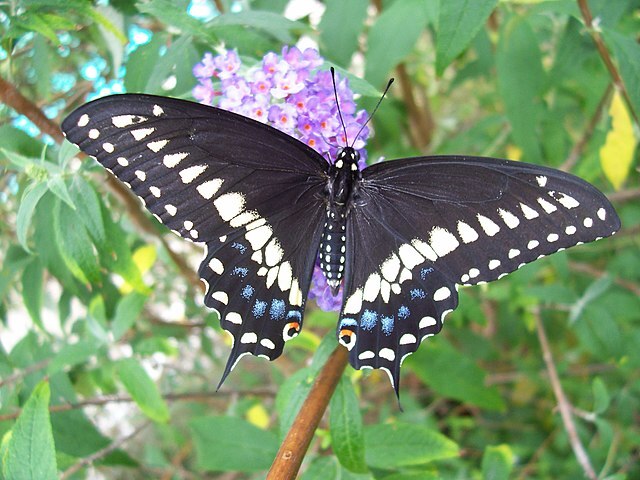
Black Swallowtail Butterfly (Papilio polyxenes)
The Black Swallowtail (Papilio polyxenes) is found mostly in eastern North America, especially east of the Rockies, with smaller populations in the southeast of California and central Mexico and it is the state butterfly of Oklahoma. These butterflies rely on many host plants that are well-known in human diets such as Queen Anne’s Lace, carrot, celery, fennel, dill, and parsnip though they sometimes also use plants in the citrus family. Black Swallowtails are widespread, sometimes producing up to 3 broods a year in the southern regions. As adults, these swallowtails feed on clover, milkweed, thistles, and many species of Phlox [pictured], a cultivated genus composed of annual or herbaceous perennials and evergreen shrubs. Like many other butterflies, Black Swallowtails prefer open and flat flowers or small clusters of flowers, thus one of its favorites is Phlox spp., which usually produces colorful, star-shaped flowers in clusters.
https://www.butterfliesandmoths.org/species/Papilio-polyxenes
https://hort.extension.wisc.edu/articles/black-swallowtail-papilio-polyxenes/
https://nhpbs.org/wild/karnerblackswallowtail.asp
https://kidsgardening.org/resources/growing-guide-plants-black-swallowtail-butterflies/
Photo by siamesepuppy, courtesy of Flickr CC BY 2.0
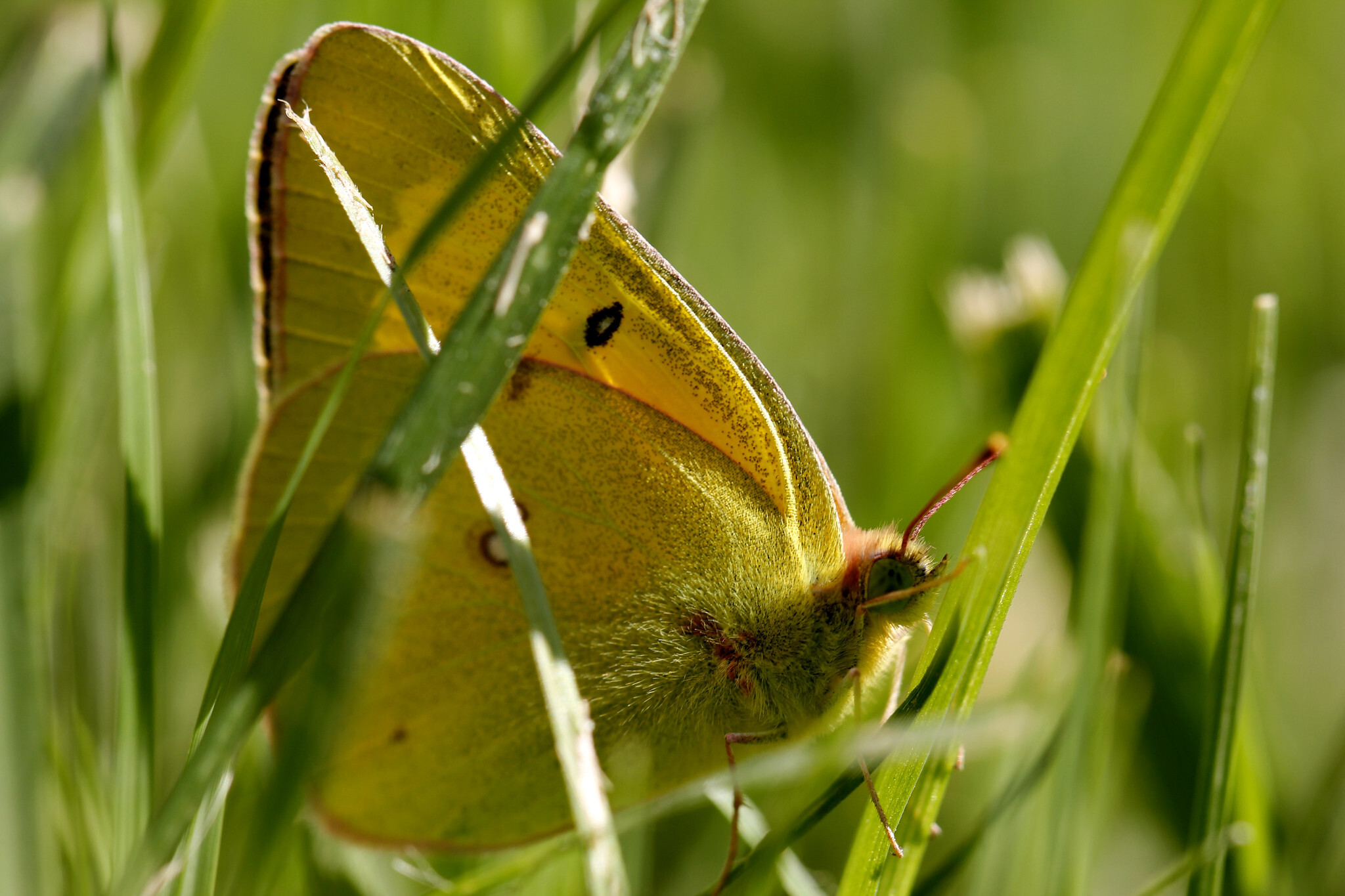
California Dogface Butterfly (Zerene eurydice)
The California Dogface butterfly (Zerene eurydice) can only be found from central California to Baja California and was therefore designated as the state insect of California in 1972. These butterflies have extreme sexual dimorphism, meaning males and females have very different coloring. Males have black forewings with a yellow to peach-colored shape that looks like a dog’s head, tinged with purple iridescence and yellow-orange hindwings. Females are completely yellow with a black spot on the forewings. As adults, they feed on many native California plants including the California buckeye tree (Aesculus californica) [pictured], which produces long, conical clusters of flowers that attract pollinators.
https://www.fs.usda.gov/wildfl...
https://www.butterfliesandmoths.org/species/Zerene-eurydice
https://sonomamg.ucanr.edu/Plant_of_the_Month/Aesculus_californica_-_California_buckeye/
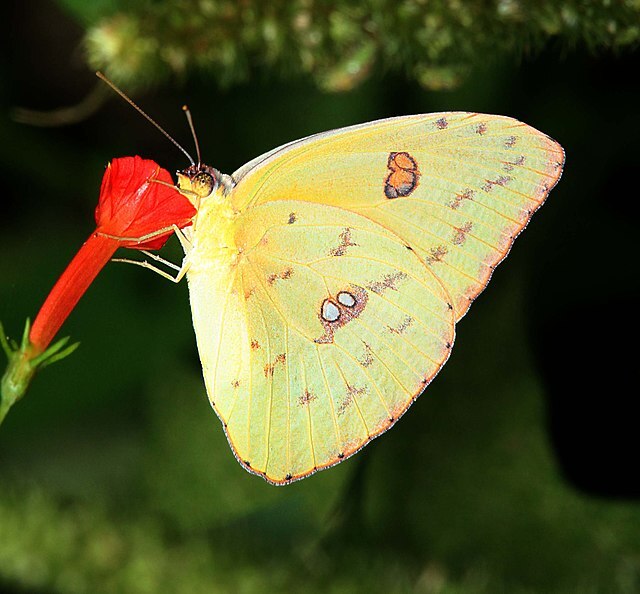
Cloudless Sulphur Butterfly (Phoebis sennae)
The Cloudless Sulphur butterfly (Phoebis sennae) gets its genus name from Phoebe, a lunar titanness in Greek mythology, and its species name from its host plant, Senna, a member of the pea family. These fast-flying butterflies can be found throughout the mainland of the U.S. and into South America to Argentina and the West Indies. They are not considered endangered. In fact, these little butterflies are abundant and can produce multiple flights a year, especially in the Deep South. Adult P. sennae have long tongues so they feed on many tubular flowers such as the Scarlet Creeper (Ipomoea hederifolia) [pictured], an annual vine with bright red flowers native to the southern U.S.
https://entnemdept.ufl.edu/creatures/bfly/bfly2/cloudless_sulphur.htm#hosts
https://www.butterfliesandmoths.org/species/Phoebis-sennae
https://www.fs.usda.gov/wildfl...
https://www.fnps.org/plant/ipomoea-hederifolia
https://www.flawildflowers.org/know-your-native-pollinators-cloudless-sulphur/
Photo by Judy Gallagher, courtesy of Flickr CC BY 2.0
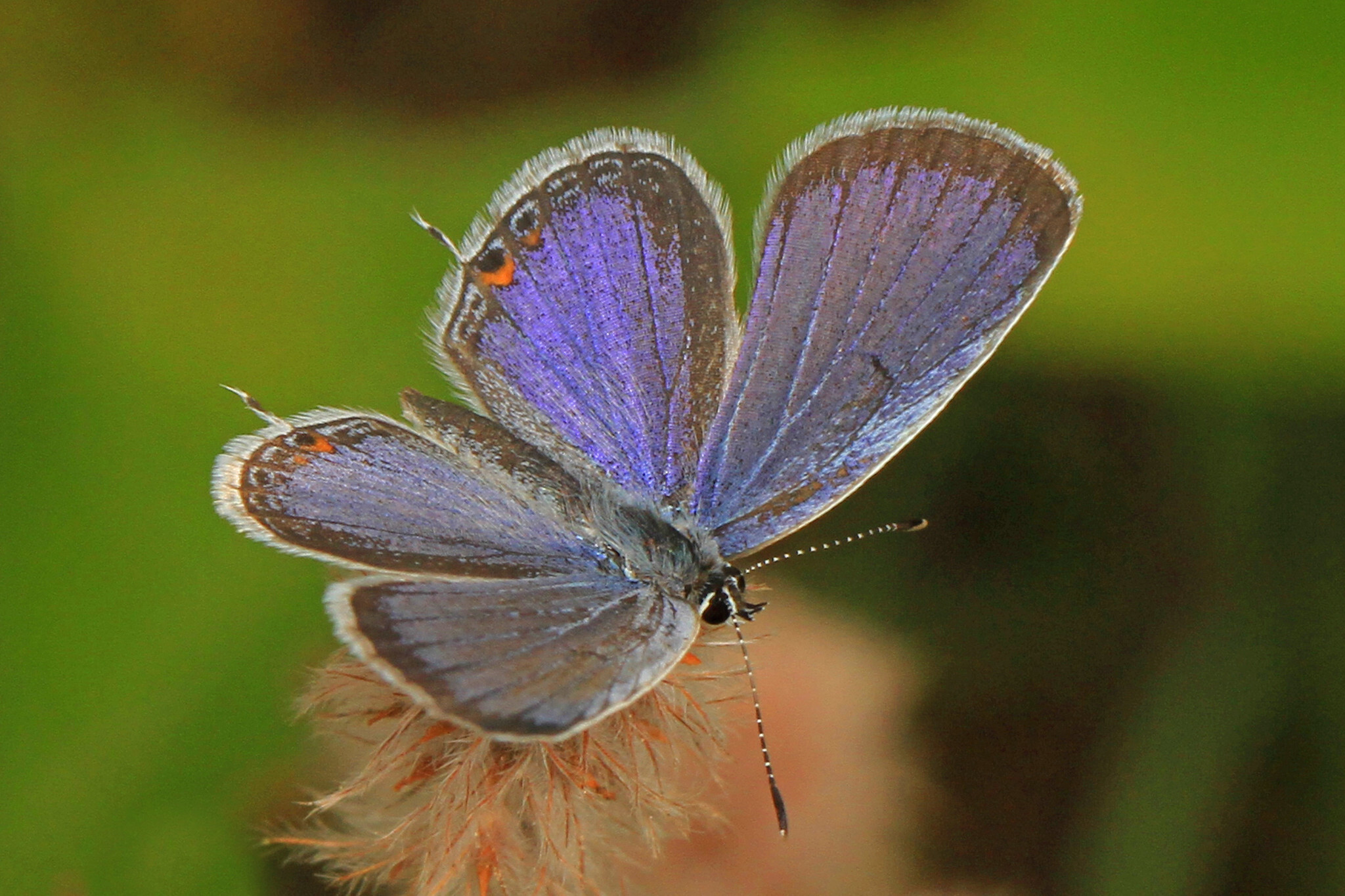
Eastern Tailed Blue Butterfly (Cupido comyntas)
The Eastern Tailed-Blue butterfly (Cupido comyntas) is a small butterfly usually found east of the Mississippi River and in some parts of the Pacific Northwest. It’s so-named because of the small tail found on its hindwing. Males have iridescent blue wings with a brownish tint on the edges while females are uniformly brown and become slightly bluer in the summer. Females will lay eggs on the flower buds of their host plants: many members of the pea family. As adults, these little butterflies are low-flying and have a short proboscis so they tend to prefer flowers that are close to the ground, open, and short-tubed such as the wild strawberry (Fragaria virginiana) [pictured].
https://www.butterfliesandmoths.org/species/Cupido-comyntas
https://animaldiversity.org/accounts/Cupido_comyntas/
Photo by Derek Ramsey, courtesy of Wikimedia Commons GNU FDL 1.2
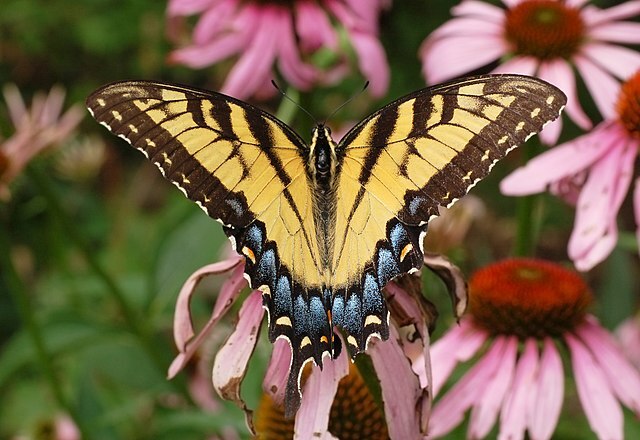
Eastern Tiger Swallowtail Butterfly (Papilio glaucus)
The Eastern Tiger Swallowtail (Papilio glaucus) is a large butterfly with a wingspan of almost 5 inches and is probably the most recognizable swallowtail. It is found throughout eastern North America from Ontario to the Gulf Coast and west to the Colorado plains and south Texas. It is also the state butterfly of Alabama, Delaware, Georgia, and South Carolina. The males are bright yellow with black tiger stripes and the females have 2 forms: one is yellow like the male and the other is black with dark stripes. The hindwing of both female forms has a blue iridescent wash and a band of blue stripes on the lower portion of the wing. The Eastern Tiger Swallowtail uses a variety of host plants to lay eggs upon, including black cherry (Prunus serotina), sweetbay Magnolia (Magnolia virginiana), and tulip tree (Liriodendron tulipifera). You might also recognize the caterpillars for their bright yellow, black and blue false eyespots, which are on the thorax behind their true eyes. Once into adulthood, these swallowtails feed on milkweed, wild cherry, lilacs, and New York Ironweed (Vernonia noveboracensis) [pictured], a native of the eastern U.S. which produces clumps of red and purple flowers.
https://www.naba.org/chapters/nabanj/butterflies/eastern_tiger_swallowtail.html
https://www.butterfliesandmoths.org/species/Papilio-glaucus
https://entnemdept.ufl.edu/creatures/bfly/tiger_swallowtail.htm
https://animaldiversity.org/accounts/Papilio_glaucus/
https://www.fs.usda.gov/wildfl...
Photo by Jill Utrup/USFWS
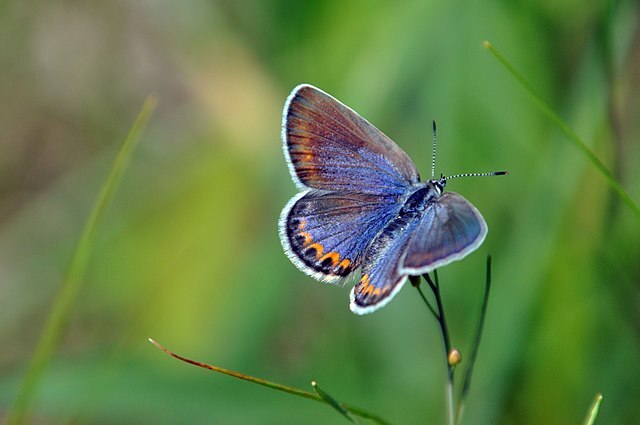
Karner Blue Butterfly (Lycaeides melissa samuelis)
The Karner Blue (Lycaeides melissa samuelis) is a small, silvery butterfly found in parts of New Hampshire, New York, Michigan, Wisconsin, and Ohio. Karner Blues have what’s known as an obligate mutualistic relationship with Wild Blue Lupine (Lupinus perennis) meaning, the Wild Blue Lupine is the only plant the Karner Blue larvae can eat. Today, Karner Blues are considered an endangered species due to the loss of habitat from a decrease in lupine patches and connectivity. Therefore, these butterflies exist in isolated populations. In adulthood, Karner Blues are known to feed on Bee Balm (Monarda spp.), [pictured], a perennial North American native with fragrant red, pink, purple, or white flowers.
https://dnr.wi.gov/topic/EndangeredResources/karner/documents/CommonNectarSpeciesKbb.pdf
https://mnfi.anr.msu.edu/species/description/11691/Lycaeides-melissa-samuelis
https://www.fws.gov/species/karner-melissa-blue-lycaeides-melissa-samuelis
https://www.butterfliesandmoths.org/species/Plebejus-melissa
https://www.fws.gov/species/karner-melissa-blue-lycaeides-melissa-samuelis
https://www.almanac.com/plant/bee-balm#
Photo by Anthony Colangelo
Monarch Butterfly (Danaus plexippus)
The Monarch butterfly (Danaus plexippus) is perhaps the most well-known butterfly in North America, recognizable by its bright orange wings with black borders, black veins, and white dots along the edges. Monarchs are full of endurance, traveling by the millions from Canada and the northern U.S. to thousands of miles away in central Mexico and the California coast for their overwintering sites. Despite this feat of migration, Monarchs are declining, most likely due to loss of habitat, loss of milkweed, and drought conditions in California, among other factors. Both the Monarch caterpillar and adult butterfly rely on milkweeds (Asclepias spp.) [pictured] as a food source. Milkweeds also contain a toxin that caterpillars accumulate in their bodies and lasts into adulthood, making them bad-tasting to predators and helping them survive. Most of the monarchs that join the migration each fall are three or four generations removed from the previous year- how monarchs navigate to the same groves of trees visited by their ancestors remains an unsolved scientific mystery!
https://www.pollinator.org/monarch
https://www.pollinator.org/pollinator.org/assets/generalFiles/NAPPC.Monarch.broch.Aug.2019.hRes.pdf
https://www.butterfliesandmoths.org/species/Danaus-plexippus
Photo by Thomas Shahan, courtesy of Wikimedia Commons CC BY 2.0
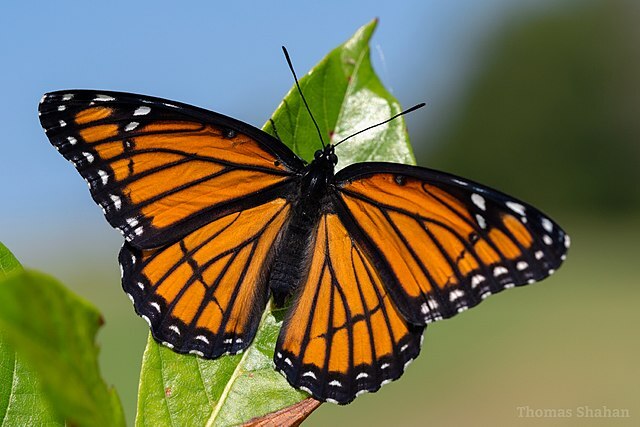
Viceroy Butterfly (Limenitis archippus)
When at first glance you think you see a Monarch butterfly, look a little more closely and if you find a horizontal black band across the back of the wing, you’ll have spotted a mimic! The Viceroy butterfly (Limenitis archippus) looks very similar to the Monarch, but is a bit smaller. The Viceroy is a Mullerian mimic of the Monarch, meaning, they evolved to look similar, and both have a chemical defense making them unpalatable to birds and ensuring their mutual protection from predators. Viceroys are found in most of the continental U.S., southern Canada, and down into central Mexico. They prefer wet habitats such as ponds, swamps, and rivers so caterpillars can feed on their host plants: willows. In adulthood, Viceroys feed on asters, thistles, and milkweeds such as showy milkweed (Asclepias speciosa) and Swamp milkweed (Asclepias incarnata) [pictured], which produces clusters of pink flowers.
https://entnemdept.ufl.edu/creatures/bfly/viceroy.htm
https://www.butterfliesandmoths.org/species/Limenitis-archippus
https://nhpbs.org/natureworks/viceroy.htm
https://www.wildflower.org/plants/result.php?id_plant=asin
Photo by Andy Reago, courtesy of Flickr CC BY 2.0
Zebra Longwing Butterfly (Heliconius charithonia)
The Zebra Longwing butterfly (Heliconius charithonia), is a striking, medium-sized butterfly with long, black wings and yellow stripes. They are found in South America and north through Central America, the West Indies, and from Mexico to South Texas and peninsular Florida. Females lay eggs on many species of passionflower (Passiflora spp.) which caterpillars feed on and acquire some of the plant’s toxins as predator protection. Adults H. charithonia's favorite plants to feed on are lantanas such as the Lantana involucrata [pictured], which produces clusters of small white or lavender flowers, or the Lantana depressa [pictured], a variety that produces clusters of yellow flowers and is native to Florida. Zebra Longwings have a variety of unique characteristics that make them distinct from other butterflies. For example, Zebra Longwings live longer than most butterflies, for up to months at a time while they continue to lay eggs. One possible reason for their increased longevity is that not only do Zebra Longwings feed on the nectar of plants, but also the pollen. Unlike other butterflies, Zebra Longwings can use their saliva to dissolve pollen and absorb its nutrients thus helping to extend their life. These butterflies also have interesting social structures. For instance, Zebra Longwings roost communally, often in the same place daily, where older butterflies will choose the best places and young butterflies are nudged out early in the morning to get going.
https://www.wildflower.org/plants/result.php?id_plant=LADED
https://www.wildflower.org/plants/result.php?id_plant=lain2
https://www.butterfliesandmoths.org/species/Heliconius-charithonia
https://entnemdept.ufl.edu/creatures/bfly/zebra_longwing.htm
https://www.fs.usda.gov/wildfl...Photo by Megan McCarty, courtesy of Wikimedia Commons CC BY 3.0
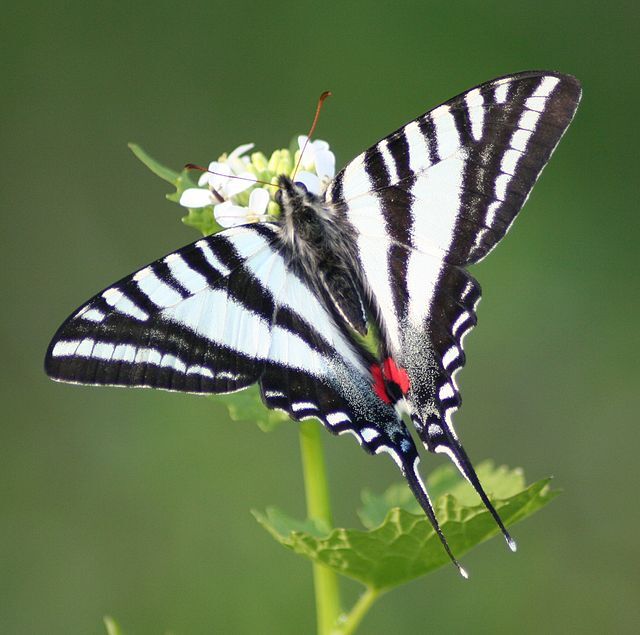
Zebra Swallowtail Butterfly (Eurytides marcellus)
The Zebra Swallowtail butterfly (Eurytides marcellus) is the only native U.S. kite swallowtail and can be found in Florida, into eastern Texas, up to southern Wisconsin, and east to New Jersey. They have black and white striped wings with long tails and a red stripe running through the middle of the hindwing. Zebra Swallowtails breed in moist, low woodlands near rivers and swamps where caterpillars can feed mostly on pawpaw (Asimina spp.). Adult E. marcellus nectar on blueberry, blackberry, lilac, redbud, viper's bugloss, verbena, dogbane, common milkweed, and Purple Coneflower (Echinacea purpurea) [pictured], a native coneflower that is very attractive to swallowtails.
https://www.butterfliesandmoths.org/species/Eurytides-marcellus
https://entnemdept.ufl.edu/creatures/bfly/zebra_swallowtail.htm#life
https://www.wildflower.org/plants/result.php?id_plant=ecpu
Featured Moths
Photo by Andy Reago, courtesy of Flickr CC BY 2.0
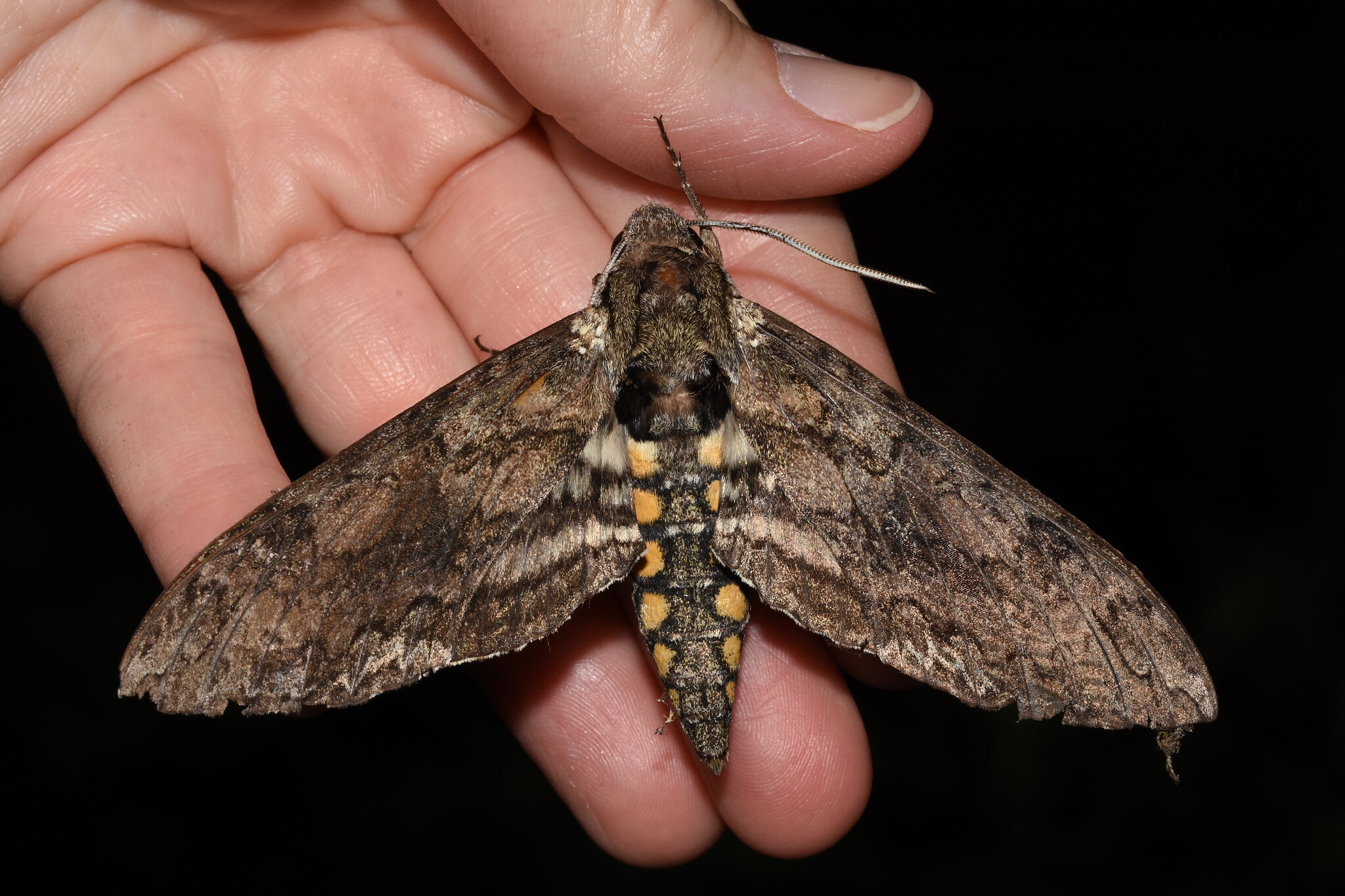
Carolina Sphinx Moth (Manduca sexta)
The Carolina Sphinx Moth (Manduca sexta) is maybe better known in its caterpillar form: the Tobacco Hornworm. Hornworms are so-called because of the red-tipped horn at the end of their abdomen. They feed on Sacred datura (Datura wrightii) [pictured], which has large white trumpet-shaped flowers, and many important human crops such as tobacco, tomato, and other plants in the nightshade family (Solanaceae). Therefore they are known as a pest in many agricultural settings. However, while the caterpillars may have a bad reputation, the adult Carolina Sphinx moth is considered a beneficial pollinator. You can spot these moths by a set of six yellow bands across their abdomens with black, brown, and gray wings. They are found throughout much of the U.S., especially in the east and across Central America and the Caribbean. M. sexta are also sometimes referred to as hummingbird moths since they can fly agilely between flowers and hover above them to extract nectar with their long proboscis.
https://entnemdept.ufl.edu/creatures/field/tobacco_hornworm.htm
https://www.butterfliesandmoths.org/species/Manduca-sexta
https://www.wildflower.org/plants/result.php?id_plant=dawr2
Photo by Dwight Sipler, courtesy of Flickr CC BY 2.0
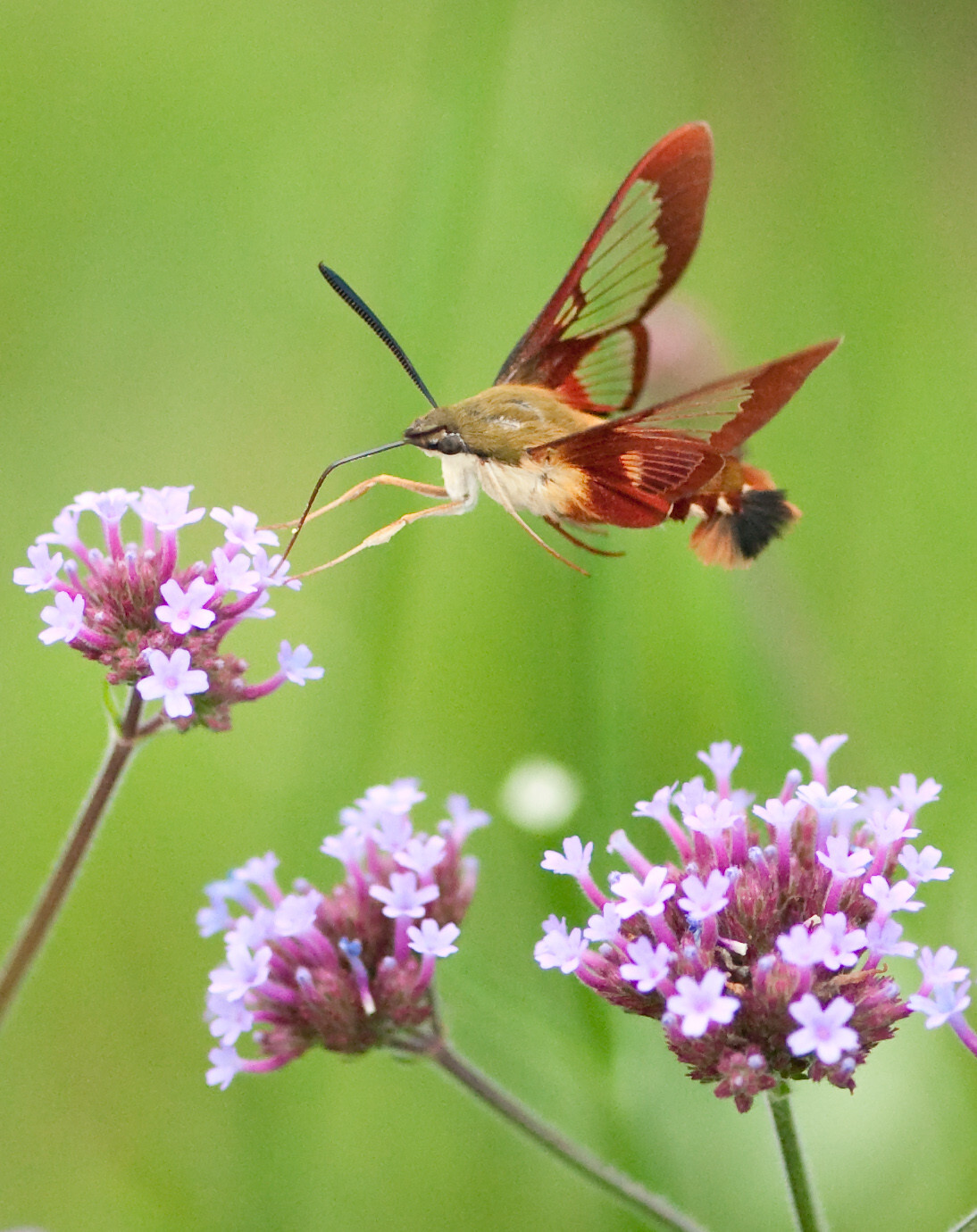
Hummingbird Clearwing Moth (Hemaris thysbe)
The Hummingbird Clearwing moth (Hemaris thysbe) is a day flier and a migratory moth. They can be found in a large portion of North America but are most commonly found in southern Ontario and the eastern United States. While all Lepidoptera have scales on their wings, H. thysbe lose their scales from patches on their wings, giving them the name clearwing moths. Like Hummingbirds, H. thysbe hovers in front of a flower while they unfurl their long tongues and insert them into long-necked flowers to sip their nectar. They even emit a faint humming sound! Their caterpillars have been recorded as relying on leaf litter for shelter during their pupa stage, so think twice before clearing those excess leaves from your garden! In adulthood, these moths feed on a variety of flowers including Liatris spp., such as Blazing Star [pictured], a native perennial that produces tall spikes of bottlebrush flowers.
https://www.fs.usda.gov/wildfl...
https://www.butterfliesandmoths.org/species/Hemaris-thysbe
https://hort.extension.wisc.edu/articles/liatris/
Photo by Gail Hampshire, courtesy of Wikimedia Commons CC BY 2.0
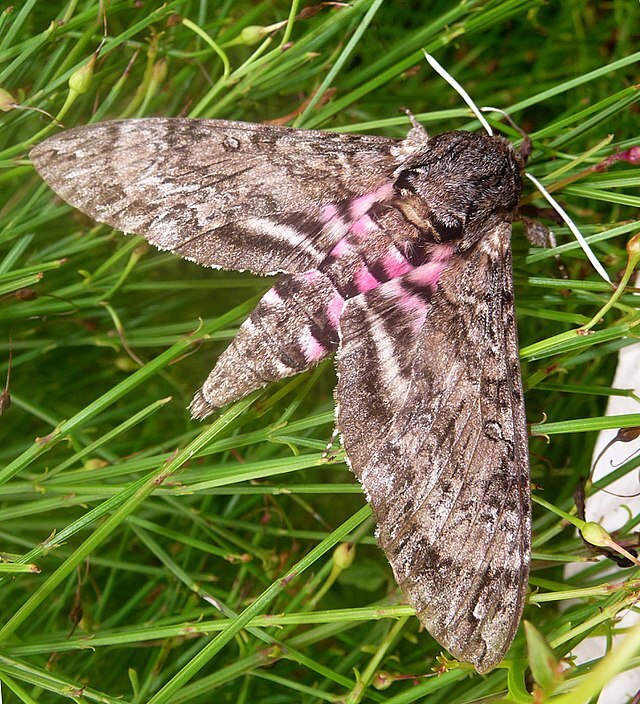
Pink-spotted Hawkmoth (Agrius cingulata)
The Pink-spotted Hawkmoth (Agrius cingulata) is a type of sphinx moth. They are large and robust moths and easily recognizable by the black and pink bands running across their abdomen. A. cingulata tend to be found in warmer climates, with their ranges stretching from central South America, Mexico, the Caribbean, and the southern United States. In the summer, they stray northward to British Columbia, Colorado, Michigan, and Maine. Caterpillars tend to feed on morning glory and sweet potato leaves, thus the larva is known as a Sweet Potato Hornworm. The adult A. cingulata is nocturnal and feeds on nectar from morning glories (Convolvulus spp.), petunias (Petunia spp.), and Moonflower (Calonyction aculeatum) [pictured], a perennial vine that gets its name from its nocturnal blooms.
https://environment.bm/pink-spotted-hawkmoth
https://bugguide.net/node/view/3084
https://www.butterfliesandmoths.org/species/Agrius-cingulata
https://calscape.org/lep/Agrius-cingulata-(Pink-spotted-Hawkmoth)?srchcr=sc5ce8922d11c74
https://plants.ces.ncsu.edu/plants/ipomoea-alba/
Photo by Christian Grenier, courtesy of Wikimedia Commons
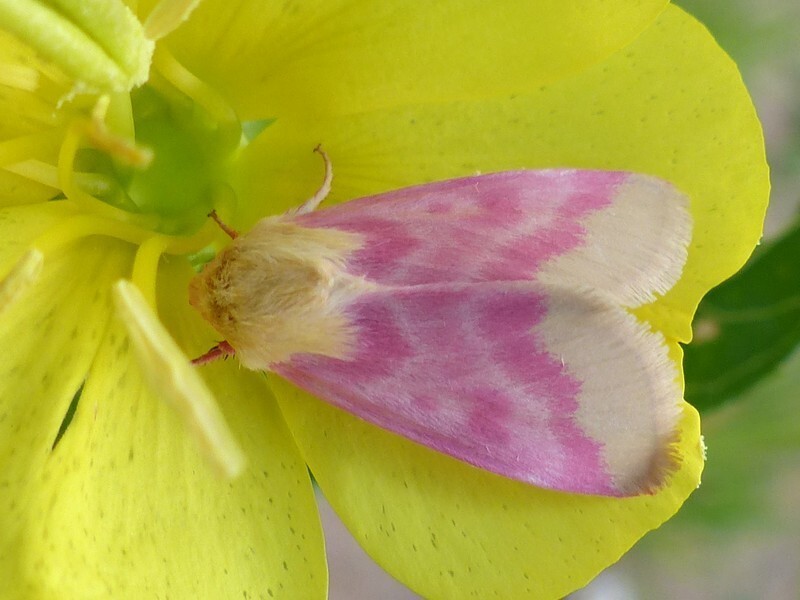
Primrose Moth (Schinia florida)
Primrose moths (Schinia florida) are small, yet striking with pink and yellow coloration on their wings. They are found throughout North America, especially from eastern Canada down to northern Florida, west to California, and north to Alberta. This species has a unique relationship with Evening Primrose (Oenothera spp.) [pictured], wherein the Primrose moth caterpillar feeds on the seedpod of Oenothera spp. and the adult nectars on its flowers, providing benefits to both the plant and moth species. Primrose moths are also exclusively nocturnal and rest during the day. In multiple cases, the moth will enter the corolla of the primrose flower, whose petals can match the yellow color of the moth’s wings and remain there for the flower to close its petals over the moth at the beginning of dawn.
https://images.peabody.yale.edu/lepsoc/jls/1970s/1970/1970-24(4)282-Hardwick.pdf
http://pnwmoths.biol.wwu.edu/browse/family-noctuidae/subfamily-heliothinae/schinia/schinia-florida/
https://www.butterfliesandmoths.org/species/Schinia-florida
Photo by Pamala Wilson, courtesy of Flickr CC BY-NC-ND 2.0
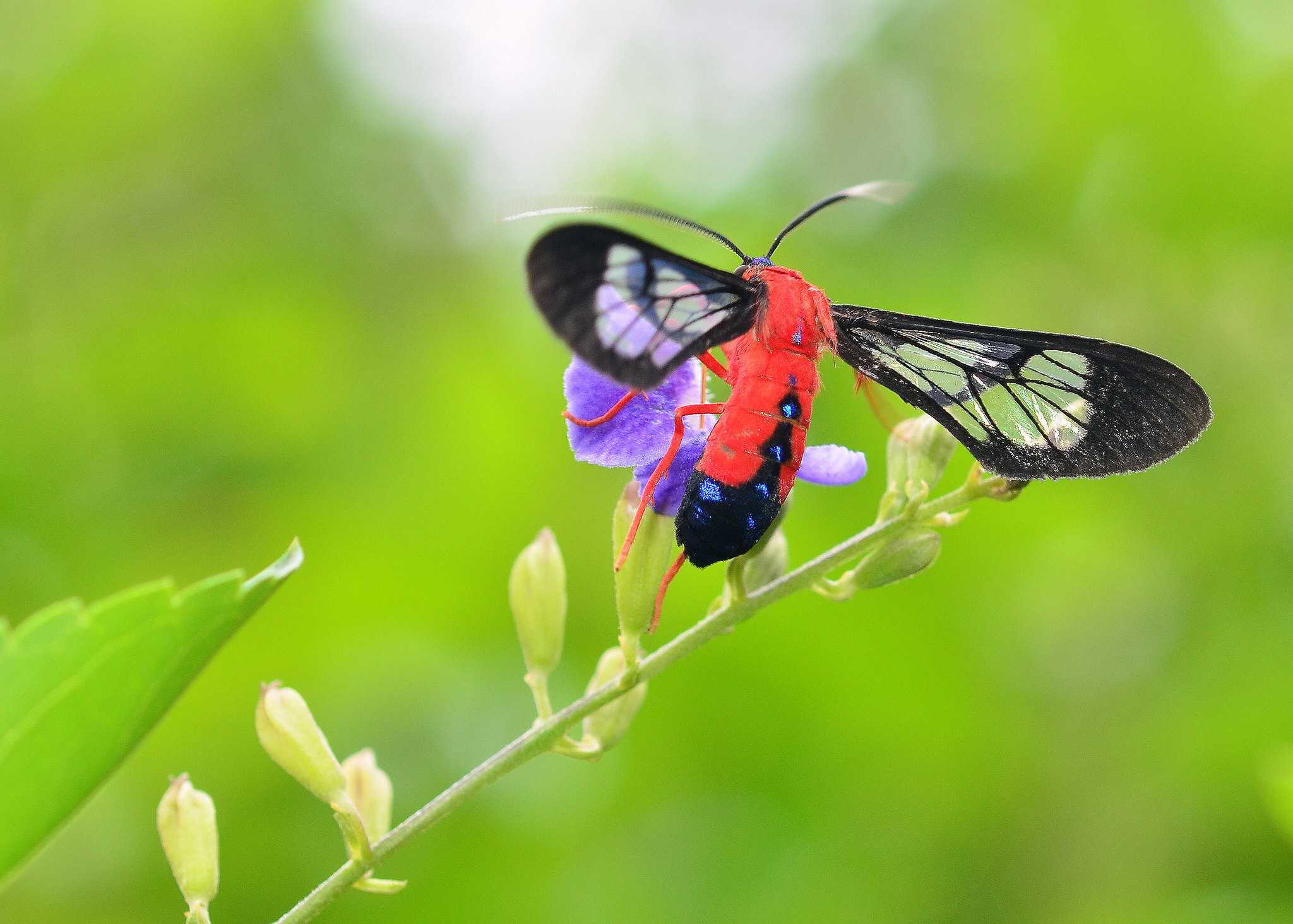
Scarlet-bodied Wasp Moth (Cosmosoma myrodora)
The Scarlet-bodied Wasp moth (Cosmosoma myrodora) is a striking insect and one of the most physically distinct moth species found in the United States. They have a bright red thorax and abdomen with metallic blue dots and transparent wings. These moths practice Batesian mimicry, meaning they develop coloration and behavior that mimic dangerous or inedible animals. In the case of C. myrodora, it is mimicking the coloration of a threatening wasp, which helps protect them against predation. Their range is throughout Florida and the coastal regions of Texas, Louisiana, Georgia, and South Carolina. The caterpillars feed on hempvine, thus they have been considered for potential biocontrol of one of the world’s worst invasive plant species, mile-a-minute vine (Mikania micrantha) because this plant belongs to the same genus as hempvine, the scarlet-bodied wasp moth’s normal host plant. Adult males feed on dogfennel (Eupatorium capillifolium) [pictured], which contains defensive compounds (pyrrolizidine alkaloids). During courtship, the male transfers these compounds to the female, which protects them from predators like the golden orb-web spider.
https://www.lsuagcenter.com/profiles/bneely/articles/page1590083677641
https://entnemdept.ufl.edu/creatures/BFLY/MOTH2/scarlet_bodied_wasp_moth.html
https://www.butterfliesandmoths.org/species/Cosmosoma-myrodora
Photo by Adam Jackson
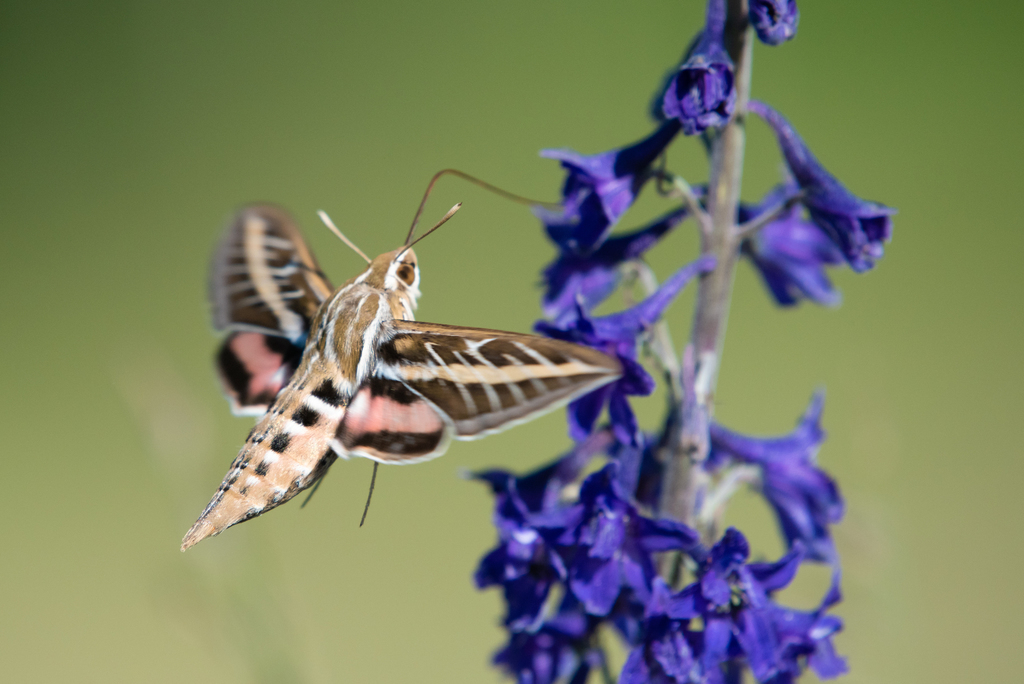
White-lined Sphinx Moth (Hyles lineata)
The White-lined Sphinx Moth (Hyles lineata) is primarily a nocturnal flier with a special attraction to night-blooming cacti like the queen of the night (Epiphyllum oxypetalum) [pictured]. The E. oxypetalum flowers only open at night and rely on evening pollinators like H. lineata. H. lineata is a prolific species and lives in most of the United States, southern Canada, Central America, and Mexico. The White-lined Sphinx Moth is characterized by its large, furry brown body, olive-colored wings with thin white stripes, and pink hindwings. The large body of H. lineata requires rapid wing beating to stay suspended. The high-speed wing movement often results in H. lineata being mistaken for a hummingbird. Females lay hundreds of eggs in the spring and at least two generations are born annually. During the pupal stage, the larvae burrow into the soil for 2-3 weeks before emerging as adults. The pupae wiggle towards the surface of the soil to easily emerge as moths. The caterpillars have a yellow or orange pointed horn with a black tip allowing them to blend in with their host plant.
https://hort.extension.wisc.edu/articles/white-lined-sphinx-moth-hyles-lineata/
http://arizonabeetlesbugsbirdsandmore.blogspot.com/2011/07/last-night-arizona-queen-of-night.html
https://www.nps.gov/cabr/blogs/species-spotlight-white-lined-sphinx-moth-hyles-lineata.htm
https://www.sphingidae.us/hyles-lineata.html
Photo by Andy Reago, courtesy of Flickr CC BY 2.0
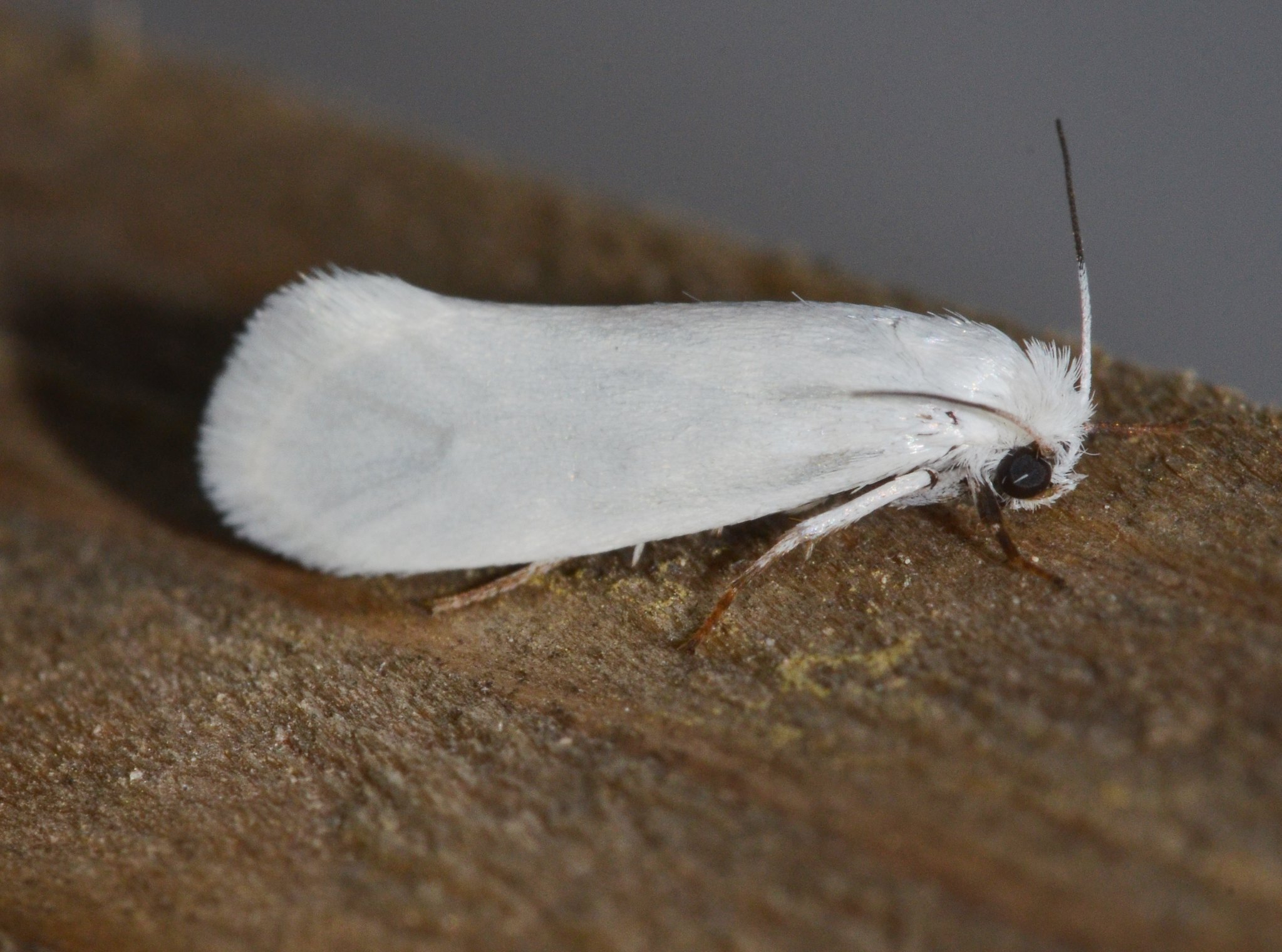
Yucca Moth (Tegeticula yuccasella)
The Yucca Moth (Tegeticula yuccasella) is crucial to the reproduction of the Yucca plant (Yucca spp.) [pictured], a perennial shrub native to the southwestern United States. Neither the Yucca Moth nor the Yucca plant could survive without the other. The female T. yuccasella removes pollen from the Yucca plant's small white flowers using special tentacles. She carries the pollen to a flower on a different plant and fertilizes the Yucca by depositing the pollen in the flowers' stigma. The Yucca Moth then will lay her eggs inside the flower and when the eggs hatch the caterpillars eat the seeds and fruit produced by the Yucca plant. The larvae then drop to the ground, form a cocoon, and bury themselves until the following spring. Yucca Moths can remain dormant for longer depending on the weather. If the Yucca flowers are unable to bloom, then T. yuccasella will stay buried for more than a year. The Yucca Moth resembles the blossoms from the Yucca plant and is small, and white.
https://www.nwf.org/Educational-Resources/Wildlife-Guide/Invertebrates/Yucca-Moths
https://www.fs.usda.gov/wildfl...
https://blog.nature.org/science/2013/03/21/the-yucca-and-its-moth/
